Ah, the joy of owning an inflatable kayak! These portable and lightweight boats have become increasingly popular among paddling enthusiasts who appreciate their ease of use and versatility. However, proper storage is crucial when it comes to maintaining your kayak’s performance, protecting it from damages, and ensuring a long lifespan. I, too, have faced the challenges of finding the best way to store my inflatable kayak, particularly in limited living spaces. That is why I have done the legwork for you, diving into extensive research to bring you this comprehensive guide on storing your inflatable kayak.
In this article, we’ll cover all the essential aspects of keeping your inflatable kayak in top shape both on and off the water. From the optimal storage conditions to a step-by-step guide on how to store it properly, I’ll share everything you need to know. Along the way, we’ll also discuss additional tips for long-term storage, hanging your kayak, and maintenance. So whether you’re new to the world of inflatable kayaks or a seasoned paddler, follow along as I share the secrets to preserving your investment and enjoying endless paddling adventures.
Contents
Contents
Why Proper Storage Matters?
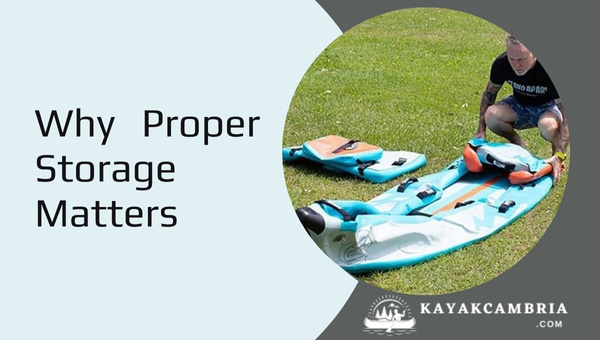
When it comes to inflatable kayaks, proper storage is crucial for maintaining the condition and functionality of your vessel. In this section, we’ll discuss why taking the time to store your kayak correctly is essential for long-lasting, enjoyable excursions on the water.
Preserve The Kayak’s Lifespan
Inflatable kayaks are made with durable materials, but they are not invincible. Just like other outdoor gear, they can degrade over time if not cared for properly. By storing your kayak appropriately, you can protect its structure, seams, and fabric, thereby extending its lifespan and ensuring you can use it for years to come.
Protect It From Damages And Wear
Even when not in use, your kayak can suffer from damage due to improper storage. Exposure to direct sunlight, severe temperatures, or pests can weaken the kayak’s material or cause it to become brittle. Additionally, folds or creases created from incorrect storage can lead to cracks and leaks. Storing your kayak correctly helps to prevent such issues, maintaining its integrity and performance.
Maintain Its Performance On The Water
Ultimately, proper kayak storage has a direct impact on how well your inflatable kayak performs in the water. A well-cared-for kayak will remain reliable, stable, and maneuverable, ensuring that you have a fantastic time during each adventure. In contrast, a poorly stored kayak may develop issues that hamper its efficiency or, worse, put your safety at risk.
2024‘s Best Storage Conditions For Inflatable Kayaks
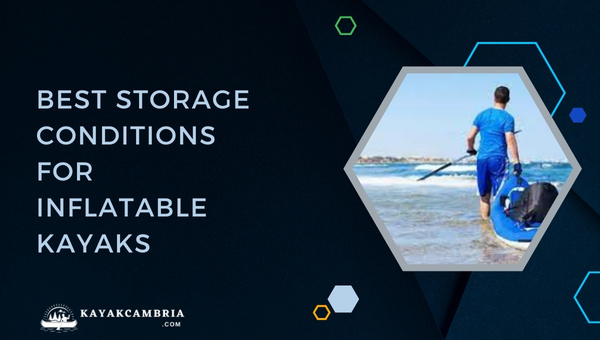
Finding the right storage conditions for your inflatable kayak is crucial to prolonging its life and functionality. By ensuring that you follow these best practices, you can protect your inflatable kayak from damages and keep it in top shape for your future adventures.
1. Store In A Dry And Ventilated Area
An inflatable kayak must be stored in a dry and well-ventilated location to avoid the growth of mildew and mold. Moisture can damage not only the kayak material but also affect the structural strength of the seams. Ideally, you should store your kayak indoors – in a garage, closet, or shed – reducing the exposure to outside elements.
2. Provide Sufficient Space
When storing your inflatable kayak, make sure there’s enough space to avoid folding or bending the kayak unnecessarily. They should be stored either flat on the ground or hung from a suitable suspension system (more on this in the hanging section below). This prevents creases and reduces potential wear and tear.
3. Avoid Direct Sunlight
Ultraviolet (UV) radiation from the sun can cause considerable damage to the kayak material over time, leading to brittleness, discoloration, and a shorter lifespan. To prevent this issue, choose a storage area away from direct sunlight or invest in a UV-resistant cover. This will protect your inflatable kayak from the harmful effects of sun exposure.
4. Keep Away From Heat Sources
High temperatures can be harmful to your inflatable kayak. So, ensure that you store it away from heat sources such as radiators, furnaces, or hot pipes. Extreme heat may weaken or even melt the kayak materials, significantly reducing their quality and durability.
5. Pests And Rodents
Make sure to store your inflatable kayak in a place that is safe from potential damage by rodents or other pests. If possible, use a durable and sealed storage bag to protect it from any unwanted critters.
Step-by-Step Guide To Storing Your Inflatable Kayak in 2024
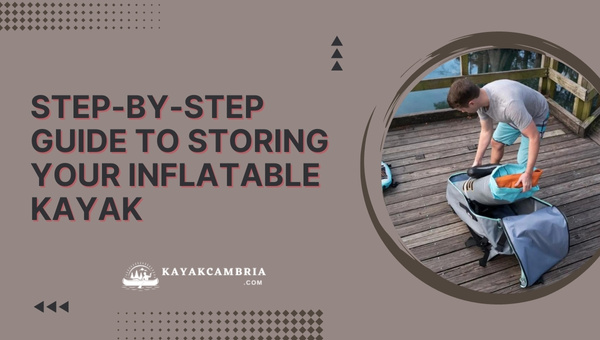
Proper storage ensures a longer lifespan for your inflatable kayak and helps maintain its performance on the water. Follow this step-by-step guide to safely store your kayak:
1. Clean And Dry The Kayak
Before storing your inflatable kayak, it’s essential to clean it thoroughly. Remove any dirt, debris, or sand using a soft brush or sponge, and then rinse the kayak with fresh water. Make sure to clean out the crevices and any hard-to-reach areas. Once it’s clean, allow the kayak to dry completely, either in the sun or by wiping it down with a towel. This will prevent mold and mildew from forming during storage.
Remember: It’s crucial to keep the kayak fully dry before storing it to avoid any damage.
2. Deflate The Kayak
Open the air valves on your inflatable kayak and allow the air to escape. To speed up the process, you can gently press on the sides of the kayak or roll it up, pressing out the remaining air. Be mindful not to press too hard to avoid causing any creases or damage to the material.
3. Fold The Kayak
Once your inflatable kayak is fully deflated, find the manufacturer’s instructions on how to properly fold it. Following their guidelines, fold the kayak neatly without creating any sharp bends or folds that could damage the material. For better protection, consider using a storage bag or cover designed specifically for inflatable kayaks.
4. Store The Kayak
Now that your kayak is clean, dry, deflated, and folded, it’s time to find a suitable storage location. Make sure the area is dry, well-ventilated, and out of direct sunlight. The kayak should be kept away from any potential hazards, such as sharp objects, rodents, or pests. If you don’t have enough space for safe storage, consider hanging or suspending your kayak using wall-mounted racks or a pulley system.
By following these steps, you ensure that your inflatable kayak is properly stored and ready for your next adventure whenever you decide to hit the water again.
Additional Tips For Inflatable Kayak Storage
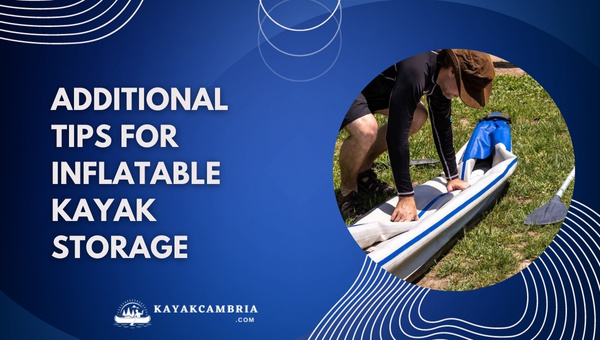
When it comes to storing your inflatable kayak, following the basic guidelines is essential, but here are some further tips to ensure your kayak stays in optimal condition.
1. Periodically Inspect Your Kayak For Damages
Regular inspections are useful to detect any damage or wear on your inflatable kayak. By doing this, you can fix minor issues before they become significant problems. The most common areas to inspect include seams, valves, and material surfaces.
2. Proper Maintenance Of The Valves And Seams
Taking care of the valves is crucial as they help maintain the right air pressure in your kayak. Regularly clean and lubricate them according to the manufacturer’s instructions. Additionally, it’s essential to check seams and connections for any signs of wear, ensuring a safe and enjoyable paddling experience.
3. Storing Accessories Separately
Store paddles, pumps, and life jackets in a separate area from the inflatable kayak. This ensures that heavy or sharp items do not damage the material while in storage. You can also use a dedicated storage bag or bin for easy organization and quick access when needed.
4. Keep Your Kayak Off The Ground, If Possible
Whenever possible, try to store your kayak off the ground to prevent damage, dirt, or moisture accumulation. You can use a storage rack, brackets, or wall-mounted hooks for this purpose.
5. Use An Inflatable Kayak Storage Bag Or Cover
An inflatable kayak storage bag or cover can help protect your kayak from dust, dirt, and direct sunlight. Moreover, these bags or covers can make transportation easier by keeping everything compact and secure.
6. Keep The Storage Area Rodent-Free And Pest-Proof
Maintain a clean and pest-free environment in your storage area to protect your kayak from damage caused by rodents, insects, or other unwanted pests. Consider using pest traps or deterrents around the storage location for added peace of mind.
By following these additional tips, you’ll be able to maintain the longevity and performance of your inflatable kayak. Taking good care of your kayak ensures that you can enjoy many seasons of paddling adventures.
Protecting Your Inflatable Kayak During Long-Term Storage

If you plan to store your inflatable kayak for an extended period, it’s essential to take extra precautions to ensure it remains in top condition. The right approach to long-term storage can save you time, money, and the headache of cleaning, repairing, or even replacing your kayak.
Preparing Your Kayak For Long-Term Storage
Before storing your kayak, follow these steps to protect it from any potential damage:
- Clean and dry thoroughly: Remove any dirt, debris, and water from the kayak. Make sure it is completely dry, as any moisture can lead to the growth of mold and mildew.
- Release the air pressure: Deflate the kayak fully to reduce the stress on its seams and material.
- Protect from UV exposure: Exposure to direct sunlight can weaken the materials of your kayak. When storing for long term, make sure the storage area is away from sunlight or use a UV-resistant storage cover.
- Use storage bags or covers: Protect your kayak from dust, moisture, and potential pest damage by using a storage bag or cover.
Checking On Your Inflatable Kayak During Storage
During the storage period, it’s essential to periodically check on your kayak, even if it’s been stored correctly. Look for any signs of damage, such as punctures, color fading, or material deterioration. Regular inspection can help you catch issues early on and address them before they become major problems.
Tips For Maintaining Your Inflatable Kayak’s Shape And Condition
Here are some additional tips to help maintain your inflatable kayak’s shape and condition during long-term storage:
- Avoid tight folds: When folding your kayak, avoid making tight or angular folds that can cause the material to weaken over time. Instead, follow the manufacturer’s folding instructions to preserve the shape and integrity of your kayak.
- Rotate your kayak: Rotate your kayak’s position in storage occasionally to prevent it from settling into one shape for too long. This can prevent indentations or creases from forming in the material.
- Keep it well-ventilated: Make sure that the storage area has proper ventilation. This will help protect your kayak from excess moisture, which can lead to mold and mildew.
How To Hang Or Suspend Your Inflatable Kayak For Storage in 2024?
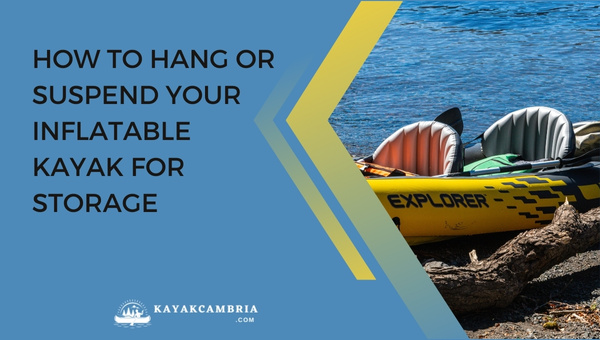
Hanging or suspending your inflatable kayak is an excellent solution for those who have limited storage space. This method not only saves space but also reduces the risk of damage due to improper folding or pressure points. Below, I will outline the process of hanging or suspending your inflatable kayak for storage, including what equipment to use and essential safety precautions.
Choosing The Right Equipment
When it comes to hanging or suspending your inflatable kayak, there are several options available, each with its benefits. Here are the top choices:
- Wall-mounted racks – These racks are designed explicitly for kayaks and can be easily attached to a wall. They provide added security and stability for your kayak.
- Pulley systems – A pulley system utilizes a series of ropes and hooks to raise and lower your kayak. This option is perfect for those with high ceilings or limited wall space.
Make sure to choose a system that can support the weight of your kayak and is compatible with your storage space.
Placement And Positioning For Weight Distribution
When hanging or suspending your inflatable kayak, it’s essential to ensure you distribute the weight evenly. This can be achieved by positioning the kayak in a way that its midsection rests on the support brackets or straps of your chosen equipment. In the case of a pulley system, multiple anchor points will ensure better weight distribution.
Here are some pointers to consider:
- Never hang your inflatable kayak using its grab handles, as this can result in damage to the seams.
- Avoid suspending your kayak by the valves or other weak points, as it can cause excessive stress and potential damage.
Safety Precautions To Avoid Accidental Damage
While hanging or suspending your inflatable kayak is an efficient storage solution, it’s crucial to follow some safety precautions to avoid any accidental damage.
- Proper securing: Make sure your kayak is properly secured by tightening all straps, ropes, or hooks as per the equipment manufacturer’s guidelines. This will prevent the kayak from slipping or falling due to improper installation.
- Check for obstructions: Be mindful of any objects, like air vents or furniture, that may come in contact with your kayak while it is suspended. Ensure there is ample clearance around your kayak to avoid potential harm.
- Periodic inspection: Regularly check the anchors, straps, or hooks for signs of wear, fraying, or corrosion, as these can compromise the system’s integrity and could result in damage to your inflatable kayak.
Transportation And Travel With Your Inflatable Kayak

Whether you’re planning a cross-country road trip or a weekend getaway, transporting your inflatable kayak safely and securely is essential. In this section, I will share some valuable tips on how to pack your kayak in a vehicle, the best approach for air travel, and ways to transport your kayak securely to new destinations.
Packing Your Inflatable Kayak In A Vehicle
- Deflate and Fold the Kayak: Start by deflating your kayak according to the instructions provided by the manufacturer. Fold it carefully, making sure to avoid sharp bends or folds that may damage the material.
- Use a Storage Bag: Place the folded kayak into a storage bag or protective case. This helps keep it contained and protected from dirt or damage during transit.
- Secure the Kayak in Your Vehicle: Position the kayak in your vehicle in a way that prevents it from moving around while driving. You can secure it with bungee cords or straps if needed.
Air Travel With An Inflatable Kayak
- Choose a Suitable Bag: For air travel, you’ll need a durable and sturdy bag that can protect your kayak from rough handling. Some inflatable kayaks come with special travel bags, or you can purchase one separately.
- Label the Bag: Clearly write your contact information on the bag to avoid misplacement.
- Weigh the Kayak: Be aware of the weight limits imposed by airlines and ensure your packed kayak isn’t too heavy. If necessary, remove some accessories from the bag and place them in your checked luggage.
- Check the Kayak: Check in your kayak as oversized baggage, and make sure to inform the airline staff of any special handling instructions if necessary.
Securely Transporting Your Kayak To New Destinations
- Use a Quality Carry Bag: A good carry bag, preferably with comfortable shoulder straps or wheels, can make transporting your kayak to the water’s edge much easier.
- Secure Loose Accessories: Ensure all accessories, including paddles, pumps, and life jackets, are also stored securely within your carry bag or attached to your kayak.
- Inspect upon Arrival: When you arrive at your destination, inspect your kayak for any damage that may have occurred during transportation. If you find any issues, address them accordingly before continuing on your journey.
Preparing Your Inflatable Kayak For Use After Storage
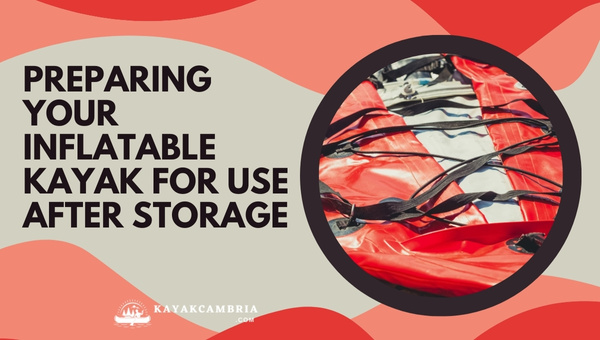
Once your inflatable kayak has been in storage for some time, it is crucial to ensure its readiness and safety before hitting the water again. This process involves a few simple steps that will guarantee an enjoyable and worry-free paddling experience. Here, I will provide you with a guide on how to prepare your inflatable kayak for use after storage.
1. Inspect For Any Damages
The first thing you should do is carefully inspect the entire kayak to ensure there are no signs of damage or wear. Pay particular attention to the valves, seams, and inflation chambers. Look for any cracks, tears, or loose parts that may have developed during storage. This thorough examination will help you identify any issues that may need repair or maintenance before using the kayak.
2. Inflate The Kayak
After confirming that your kayak appears to be in good shape, the next step is to inflate the vessel properly. Following the manufacturer’s instructions, use the recommended pump to inflate each chamber accordingly. Be careful not to overinflate or underinflate the kayak, as this can affect its performance on the water.
3. Check For Air Leaks
Once your inflatable kayak is inflated, it is essential to check for air leaks. You can do this by applying a soapy water solution to the valves and seams while listening for a hissing sound. If you notice any bubbles or hear the sound of escaping air, this is a sign that there is a leak that needs to be addressed before use.
4. Ensure All Accessories Are Ready And Functional
Before you embark on your next adventure, double-check that all the kayak’s essential accessories are ready for use. This includes your paddle, pump, life jacket, and any other necessary equipment. By inspecting the condition and functionality of these tools, you can ensure your safety and preparedness on the water.
5. Test Paddle In A Controlled Environment
Finally, it’s good practice to take your kayak for a test paddle in calm, shallow water before venturing into less predictable conditions. This test run allows you to verify if any issues could impact the performance or safety of your inflatable kayak. It’s also an excellent opportunity to get familiar with your kayak again before diving into more extensive paddling trips.
Taking the time to properly prepare your inflatable kayak for use after storage is vital to ensure optimal performance, safety, and overall enjoyment on the water. Following the steps outlined above will help you avoid any potential hazards and ensure that your kayak is ready for your next adventure.
What To Do If You Spot Damage During Storage Or After Use?
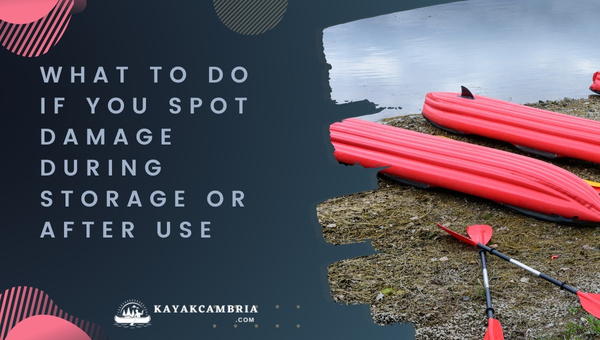
Inflatable kayaks are durable, but they can still suffer from wear and tear, especially after regular use or during long-term storage. If you spot any damage on your kayak, it’s essential to address it immediately to maintain its performance, safety, and longevity. Here, I’ve outlined the steps you can take if you notice damage to your inflatable kayak.
1. Identifying Common Issues With Inflatable Kayaks
Before diving into repairs, it’s crucial to familiarize yourself with the common problems that inflatable kayaks can face. Some typical issues include:
- Punctures or leaks: Small holes or cuts can cause air loss, affecting the kayak’s buoyancy and stability.
- Seam damage: The seams of an inflatable kayak can weaken or come apart, leading to more significant air loss or instability.
- Valve malfunction: Damaged or malfunctioning valves can make it difficult to inflate or deflate the kayak properly.
- Mildew or mold: Storing a damp kayak can encourage mold or mildew growth on the kayak’s material, leading to unpleasant odors and possible health risks.
2. Performing Minor Repairs And Maintenance
If the damage is not too severe, you can attempt to repair it yourself. First, consult your kayak’s owner’s manual for guidance on addressing minor issues. Most inflatable kayaks come with a repair kit, but you can also purchase one at a local outdoor store or online.
For punctures or leaks:
- Clean the area around the damage with a mild soap solution.
- Apply a patch by following the instructions on the repair kit. Make sure the patch is larger than the hole and use a generous amount of adhesive to ensure a proper seal.
- Allow the adhesive to cure for the recommended time before inflating the kayak and testing the repair.
For seam damages:
- Deflate the kayak and clean the damaged seam area with a mild soap solution.
- Apply seam sealer or adhesive evenly on both sides of the seam, ensuring proper coverage.
- Press the seam together and clamp it with clips or clothespins while the adhesive cures.
- Test the repair by inflating the kayak and checking for air loss.
3. Consulting A Professional For Kayak Repairs
Certain damages, like significant seam separation or multiple leaks, require the expertise of a professional. Reach out to the manufacturer or a local outdoor store for recommendations on trusted repair services. Keep in mind that ignoring or improperly fixing serious issues may result in permanent damage, reduced performance, or safety hazards during kayaking adventures.
Remember, proper storage and regular maintenance will go a long way in preserving your inflatable kayak’s life and ensuring your safety on the water. But if you ever find yourself facing damages, it’s essential to know how to address them effectively.
Storing Your Inflatable Kayak During Changing Seasons
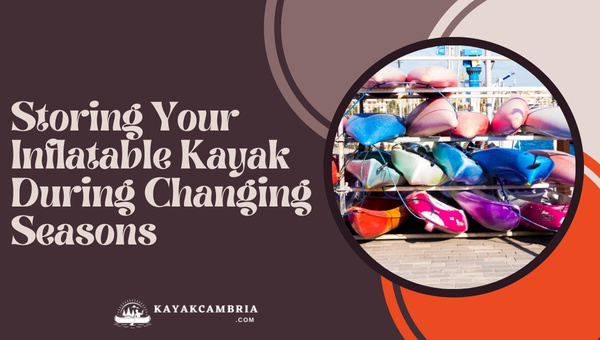
As a proud owner of an inflatable kayak, I’ve found that the challenge of storing it doesn’t end with finding the perfect spot in the house or using the right techniques. Equally important is knowing how to adapt the storage process to various seasons and weather conditions. Below, I share my most effective tips for maintaining your inflatable kayak all year round.
Adapting Your Storage Technique For Cold Temperatures And Winter Months
- Store Indoors: During winter, it’s best to keep your kayak stored indoors. Make sure it’s sheltered from elements such as snow and ice, which could cause damage to the material over time.
- Remove air before storage: In colder temperatures, the air contracts, which might damage your kayak. Be sure to deflate it entirely before storing it.
- Lay it flat: Avoid hanging your inflatable kayak during the winter months. Instead, lay it flat to minimize the risk of stretching or damaging the material under the weight.
- Avoid extreme temperatures: Sudden temperature changes can affect the integrity of your kayak, so store it in a place with a stable temperature.
Proper Care For Your Kayak During Summer Heat
- Protect from sunlight: In summer, excessive heat and sun exposure can cause your kayak to expand or degrade. Store it in a shaded, well-ventilated area away from direct sunlight.
- Keep it fully deflated: Your kayak may expand in the heat, so to avoid damage, keep it fully deflated when not in use.
- Check for damages: Exposure to summer heat and UV rays can weaken the material, seams, and valves. Inspect your kayak regularly to make sure it’s in good condition.
Tips For Maintaining Your Inflatable Kayak All Year Round
- Follow manufacturer guidelines: Always adhere to the manufacturer’s storage guidelines to prolong your kayak’s lifespan.
- Inspect regularly: Before and after each season, thoroughly inspect your kayak for any signs of wear, damage, or mold/mildew growth. Address any issues promptly to avoid further complications.
- Keep it clean: Between uses or seasons, give your kayak a thorough cleaning to remove dirt, debris, and any residue that may have built up.
Frequently Asked Questions
1. Can I store my inflatable kayak inflated?
No, it is not recommended to store your inflatable kayak fully inflated. Doing so can cause damage due to air pressure changes and added stress on the seams, valves, and fabric.
2. Is it safe to store my inflatable kayak outside?
It depends on the conditions. Ideally, you should store your kayak in a dry and covered area. If that’s not possible, make sure to protect it from direct sunlight, pests, and any harsh weather conditions (like rain, wind or snow) with a durable cover.
3. Can I fold my inflatable kayak for storage?
Yes, folding your inflatable kayak properly is essential for compact storage. Follow the manufacturer’s instructions for folding and make sure not to apply excessive force or create sharp bends that can damage the material.
4. How do I prevent mold and mildew from forming during storage?
To prevent mold and mildew formation, make sure your inflatable kayak is completely dry before storing it, and always store it in a well-ventilated area that allows airflow.
5. When should I inflate my inflatable kayak after taking it out of storage?
Inflate your inflatable kayak only after you thoroughly inspect it for any damage or issues. Doing this ensures that your kayak is water-ready and safe for your adventures.
6. How often should I check on my inflatable kayak during storage?
Regularly inspecting your kayak for any damage or wear is a good practice. The frequency can vary depending on your usage, but once every one to three months is a good starting point.
7. Can I hang my inflatable kayak on a wall or from my garage ceiling?
Yes, you can hang or suspend your inflatable kayak from a suitable wall rack or pulley system. Just ensure that the kayak is supported evenly and securely to prevent any damage during the suspension.
8. Can I leave accessories like paddles, pumps, or life jackets in the same storage bag as my kayak?
It’s best to store your inflatable kayak accessories separately to avoid added pressure or damage to the kayak fabric during storage. Moreover, keeping them organized makes it simpler to locate the required items when you’re planning your next trip.
9. Should I repair small damages (like leaks) myself or consult a professional?
For minor damages or leaks, you can often use DIY repair kits provided by the manufacturer. However, for more severe issues or damages that you are unsure about, it’s always best to consult a professional to ensure the kayak’s longevity and your safety.
Conclusion
Proper storage and maintenance of your inflatable kayak greatly contribute to its longevity and performance. With these guidelines, you’ll be well-equipped to store your inflatable kayak and keep it in optimal condition. Remember to always follow the manufacturer’s recommendations and adapt your storage techniques according to specific needs and seasons.
In this way, you’ll surely enjoy a fantastic kayaking experience for many years to come! So, find that perfect storage spot for your kayak, keep an eye on its condition, and never forget to appreciate the convenience of owning an inflatable model.

